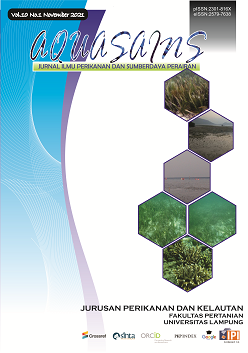Ecological Conditions of Enhalus acoroides (Linnaeus f.) Royle, 1839 and The Influencing Factors at Sari Ringgung Beach, Pesawaran District, Lampung
DOI:
https://doi.org/10.23960/aqs.v10i1.p995-1004 Abstract View: 270
Abstract View: 270
Abstract
This research was conducted from May to June 2020, located at Sari Ringgung Beach, Pesawaran District, Lampung Province. This study aims to assess the ecological conditions of Enhalus acoroides seagrass and to analyze the relationship between Enhalus acoroides ecosystem and water quality. Determination of observation points using purposive sampling method. Data on seagrass conditions and measurement of water quality parameters were carried out using a quadratic transect measuring 50 cm x 50 cm. The relationship between seagrass density and coverage with water quality parameters was tested using principal component analysis (PCA). The results showed that the type of seagrass vegetation at Sari Ringgung beach was single with the type of seagrass Enhalus acoroides. The highest average density value of Enhalus acoroides was at station 3 with a range of 76 individuals / m2 and the lowest density was at station 1 with a range of 36 individuals / m2. Meanwhile, the highest average value of Enhalus acoroides cover was at station 3 with a range of 48.48% / m2 and the lowest was at station 1 with 25.0% / m2. Seagrass density and cover have a positive correlation with phosphate, temperature, depth, brightness, and current and negatively correlated with parameters TDS, TSS, salinity, dissolved oxygen (DO), pH and nitrate.

.png)










